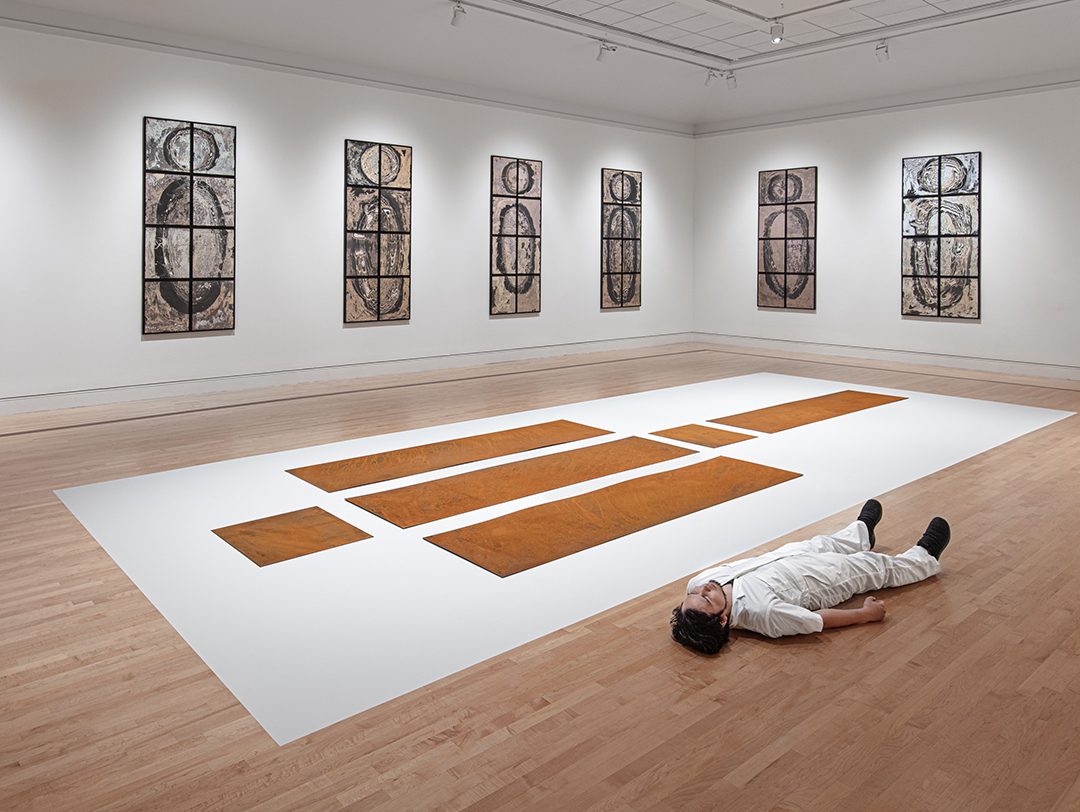 Image of artist Kei Ito.
Image of artist Kei Ito.
“How do you capture something that is not in front of you?”
An interview with artist Kei Ito
For Kei Ito, the bombing of Hiroshima in 1945 is just as palpable and present now, nearly 80 years later, as it was the day his grandfather survived it. He carries the weight of the trauma with him as though he experienced it himself. He remembers his grandfather’s description of the bombing vividly. “It was like a hundred suns lighting up the sky,” he recalls his grandfather saying.
In his exhibition at the Georgia Museum of Art, “Staring at the Face of the Sun,” Ito’s “irradiated histories” examine the detrimental effects of nuclear weapons and the possibility of healing and reconciliation. Ito’s works span five galleries and collectively serve as an early career survey while honoring his grandfather’s legacy as a survivor. Following the bombing of Hiroshima, Ito’s grandfather became an outspoken anti-nuclear activist who gave “talks at the UN, in Russia and the United States, both official and unofficial, at protests, conferences, all sorts of these things,” Ito said. Sadly, radiation, the weapon’s unseen destruction, led to his grandfather’s untimely death from cancer when Ito was just nine years old.
Born in Tokyo, Japan, Ito moved by himself to New Zealand when he was in high school. There, he found the initial spark for his passion for art and photography. After high school, he followed his interest in art to the United States and earned his undergraduate degree in art from the Rochester Institute of Technology. He then moved to Baltimore, where he obtained his master of fine arts degree at the Maryland Institute of Art.
His current exhibition is a testament to his belief in the power of performance or installation art. By creating the experience of “temporal monuments” for viewers, the exhibition explores the potential dangers of nuclear weapons through the lens of collective trauma. The experience is meant as a catalyst for deep contemplation and thorough examination by visitors. Through cameraless photography, the oldest form of photography, Ito uses motion, breath, light and chemical reactions — the seen and unseen — to mimic the complicated reality of the obvious, the subtle and even the invisible dangers of nuclear weapons.
“When I was starting to make work about nuclear issues, I wondered: How do you capture something that is not in front of you? If the camera is a device that has a lens pointed forward and captures what exists in front of you, how do I capture something that's gone or invisible, like radiation or history or memory?” he said. “My answer was to get rid of the camera and channel into the most basic component of photography: light.”
“I think about the idea of light and myself as a containment of this light a lot,” he added. “Without a camera, I focused in on the idea of everything as photography; myself as a camera or film containing this idea of capturing light and irradiated trauma.”
For Ito, the point is to get viewers to stop, pause and consider fully the cost of nuclear warfare and conflict. When it comes to the idea of war, “it’s an abstract concept for most Americans. It’s something they read about on Twitter (X), see on the news or maybe read about in a newspaper,” he said.
“My belief in art is not to present a solution, but rather to try to question or propose a question to the audience,” he said. “Even though global world conflict has gone to a terrible place these days, from an American perspective these conflicts usually happen outside of everyday life.”
However, nuclear weapons have always and continue to pose an equal threat to everyone. Americans, for example, were actually the first victims of nuclear weapons. Scientists in direct contact with weapons, as well as people in communities in close proximity to government testing sites, known as downwinders, died because of exposure to radiation.
“I hope this exhibition can bridge the irradiated traumahood between Japanese and American victims and ultimately serve as a reminder not to repeat the same tragedy,” he said. “Anyone in today’s world could be a victim of a nuclear weapon.”
The exhibition’s five galleries of works, powerful when experienced as a collective, command attention and consideration from visitors. As installation art, these temporal monuments create an atmosphere that ultimately implores visitors to see things from a more understanding perspective.
“Usually, when someone goes to a memorial, even if they don't know what the memorial is about initially, they feel a certain emotional empathy,” he said. “I’ve tried to create art that applies empathy to the realization of our standing today. Knowing where we stand allows us to determine where we go from here.”
